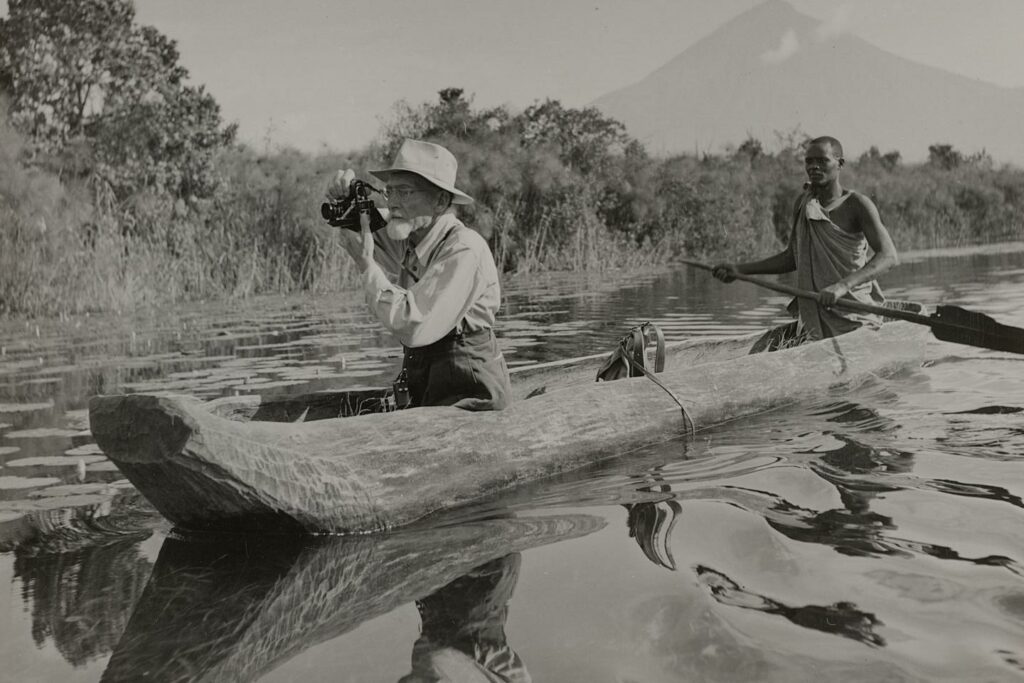LETTER FROM ZURICH
Swiss geologist Arnold Heim on an expedition to Virunga on Lake Mutanda (Uganda) in 1954. His expeditions were largely financed by oil companies. He would later become a defender of nature and a supporter of decolonization. ETH-BIBLIOTHEK ZüRICH / MUSéE NATIONAL ZURICH
There was an embarrassing moment dating back to July 13, 2017, when Doris Leuthard, who was then the president of the Swiss Federal Council, made a trip to Benin and visited Ouidah, a city notorious for its role in the slave trade. At the Porte du Non-Retour (“Door of no Return”) the memorial facing the Atlantic Ocean, she said: “This part of Benin’s history is a tragedy. (…) I’m pleased that Switzerland never took part in either slavery matters or colonization.”
Seven years later, a major and revealing exhibition at the Musée National Suisse, in Zurich, is devoted to “the history of slavery and colonization,” through the prism of Swiss participation over four centuries, putting the lid on years of amnesia and denial. Sober, precise and superbly documented, the exhibition presents 11 “fields of action” and individual case studies.
From the 16th century, Helvetian entrepreneurs and trading houses – the precursors to Switzerland’s thriving commodities trading today – were doing lucrative business in the European colonies in Africa, Asia and the Americas, importing and exporting commodities such as sugar, coffee, cocoa and tobacco, as well as textiles such as cotton and Indian printed fabrics. The Basel Evangelical Missionary Society as well as the Volkart family in the industrial town of Winterthur, long renowned for its spinning mills, established businesses in areas occupied by the great powers, and became ancillary to the first stages of globalization. Swiss banks provided the capital to develop the global network.
About 250 companies and individuals, as well as some communities, were involved in the transatlantic slave trade. Figures show that they participated in the deportation of around 172,000 people out of a total of 12 million enslaved Africans. In 1864, the Bern Federal Council even wrote that slavery was “an act which does not imply a crime.”
“Switzerland, not involved? The universities of Geneva and Zurich have long been home to some of the most closely followed anthropology institutes in Europe, where racialist theses on the intrinsic superiority of the white man were in vogue,” said Denise Tonella, the director of the Musée National Suisse. “Following on from the Black Lives Matter movement, a great deal of research has dissected the mechanisms of Swiss participation in Western imperialism, and in the context of colonialism without colonies, this global history of violence. A critical assessment has broadened the perspective on our own history.”
You have 52.16% of this article left to read. The rest is for subscribers only.
Source link : http://www.bing.com/news/apiclick.aspx?ref=FexRss&aid=&tid=6719275647b941dbbf949075b968cd47&url=https%3A%2F%2Fwww.lemonde.fr%2Fen%2Finternational%2Farticle%2F2024%2F10%2F23%2Fexhibition-takes-rare-look-into-switzerland-s-colonial-past_6730249_4.html&c=7251392251713826588&mkt=en-us
Author :
Publish date : 2024-10-23 07:57:00
Copyright for syndicated content belongs to the linked Source.
